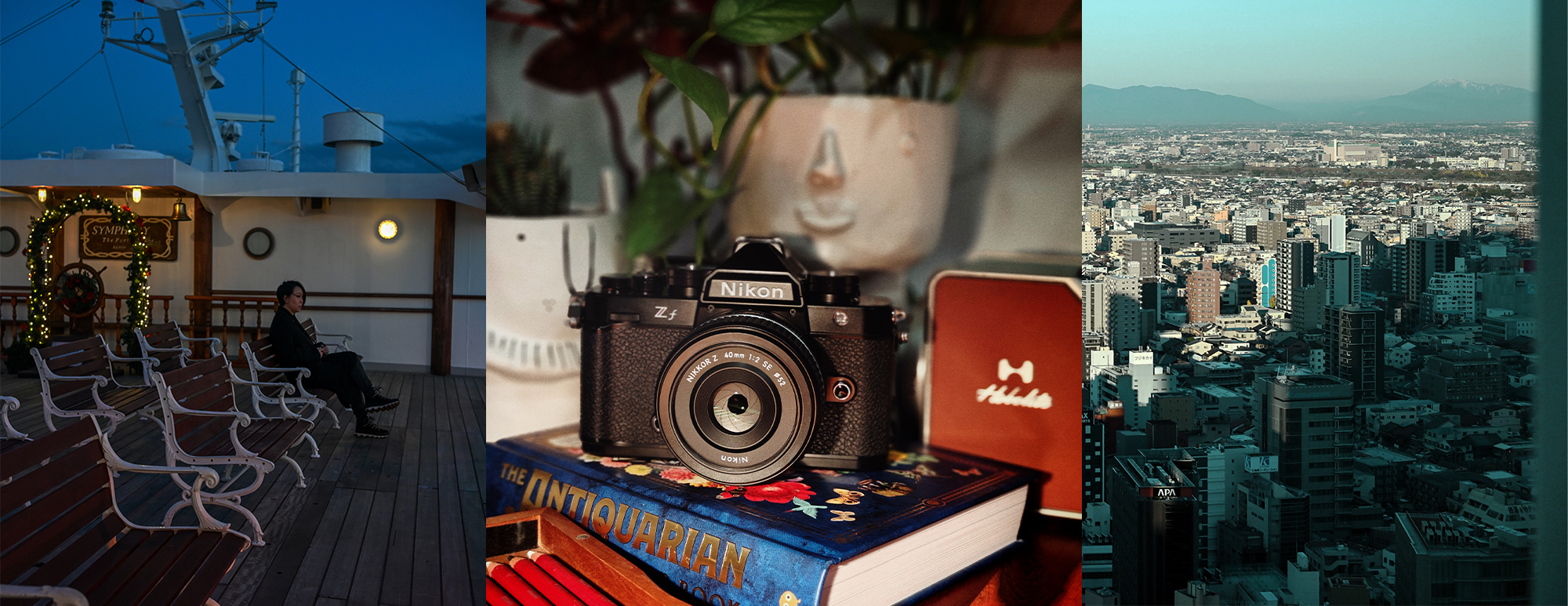My first “real” camera was a Nikon Df. It had full manual controls (apart from the autofocus), and it was packaged in a super cool retro design. The Df still remains a popular camera and those who own one refuse to let it go (which also means the camera keeps its value and market price). Now 10 years later, Nikon launches another highly desirable model with an equally cool throwback design, the Nikon Z f.

Above: The Nikon Z f in black with nikkor z 40mm f/2 (se) lens.
The Nikon Z f is a full-frame mirrorless camera that’s comes in a recognisable, iconic design, is fairly light and compact, and has all the technological bells and whistles to make this a modern marvel of a camera.
DESIGN
If the camera design looks familiar, that’s because it’s modelled after the original Nikon FM2 SLR from 1982. The viewfinder shape, the retro Nikon logo, and textured wrap all pay homage to the FM2’s heritage design; and while it’s slightly bulkier than the FM2, it’s far more compact than the Nikon Df.

Above: (from left to right) The Nikon FM2, Nikon Z f and Nikon DF.
With the Nikon Z f, the brand really got quite a few things right: it has a magnesium-alloy body (a material that is corrosion-resistant and lightweight), globally, it’s available in six premium exterior colour options (in Singapore, the camera comes in black as default), and it has the same EXPEED 7 image-processing engine as the flagship Nikon Z 9.

Above: the colour wraps for the nikon z f. photo from nikon.
At the time of writing this, the Z f is only available for pre-order in Singapore, and we heard that the waitlist is until May 2024! And it’s understandable why this camera is becoming Nikon’s next blockbuster; it doesn’t just look good, it’s really easy to use and takes excellent pictures.
EASY TO USE
I love that the dials for ISO, exposure compensation and shutter speed are placed on the top plate of the camera — all easily adjustable, and these are made of brass that feels solid and of high quality.

Above: The dials on the top of the camera.
The back of the camera features a touchscreen that can be flipped out and turned around when you need to store and protect it. And like all touchscreens, it’s intuitive; you can change settings and set your focus with a simple touch where you want it.

Above: the touchscreen that can be flipped out and turned around.
THE LENS
You can order the Nikon Z f on its own ($3,299 for just the body), or in a bundle kit with the NIKKOR Z 40mm f/2 (SE) lens ($3,699) or NIKKOR Z 24-70mm f/4 S lens ($4,199). I brought the 40mm lens along with me to Japan; it’s small and light, and is a good focal length for pretty much any type of photography (street, architecture, landscapes and even portraits).

Above: the NIKON Z F + nikkor z 40mm f/2 (SE) lens.
PHOTO QUALITY
While there are tons of presets (like Deep Tone Monochrome and Rich Tone Portrait) to use, I chose to shoot the following photos in the camera’s default mode, to capture the sights of Japan in all its original glory.

Above: The Tokyo Train Station | ISO125, f/2.0, 1/1000 sec

Above: The nikon z f is fast and easy to use. here, i did a quick capture of a plane in the sky. | ISO1250, f/5.0, 1/500 sec

Above: View from the Nagoya JR Gate Tower Hotel (you can see mount fuji on the far right). the nikon z f has an all-new Pixel-shift shooting feature that reduces moiré, false colour, and noise. | ISO400, f/5.6, 1/1000 sec

Above: the volcano at tokyo disneysea. This photo was a tricky one with the sun high in the sky backlit against the crowd. | ISO100, f13, 1/500 sec

Above: this is a night shot of me taken by my 12-year-old on a sunset cruise. even with manual focusing and in low light conditions, there’s subject detection. | iso2000, f/4.0, 1/125 sec
SPECIFICATIONS

Visit Nikon’s WEBSITE for full specs.
The NIKON Z F + nikkor z 40mm f/2 (se) is priced at $3,699 and available for pre-order at nikon retailers.











You must be logged in to post a comment.